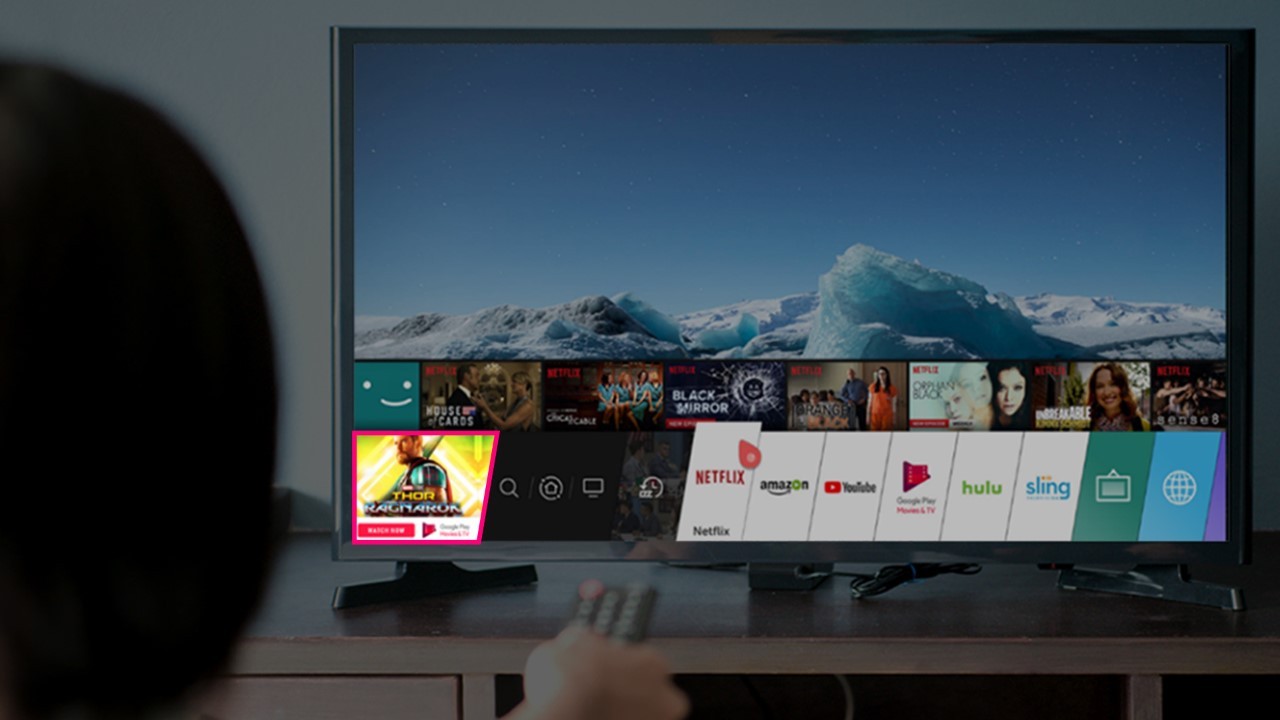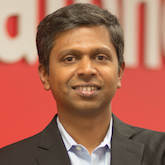LG Aims for Roku’s Advanced Ad Marketshare
Chief product officer Raghu Kodige lays out the strategy behind the Korean CE brand’s recent $80 million investment in Alphonso

In January, South Korea’s LG Electronics—the No. 4 seller of smart TVs to the U.S., controlling around 12% of the market—made two big moves.
First, the company upgraded webOS to version 6.0. The updated operating system controls LG’s OLED, QNED Mini LED, NanoCell and UHD smart TVs. In addition to the system upgrade, LG acquired a controlling stake in data and analytics company Alphonso for $80 million. The acquisition was a clear sign that LG’s aim was to build an advertising business on their smart TV platforms in order to compete with companies like Amazon, Roku, Samsung, and Vizio.

"Our investment in Alphonso is a key component of our digital transformation strategy focusing on AI, big data and cloud to fundamentally change how consumers interact with their devices," said LG Home Entertainment president Park Hyoung-sei, in a statement. "With Alphonso's TV data analysis capabilities, LG will be able to provide even more customized services and content to consumers and we are proud to welcome Alphonso to the LG family."
Founded in 2012, Alphonso bridges the gap between TV viewing and the internet, which allows advertisers to target viewers on connected TV’s.
Raghu Kodige is LG Ads’ chief product officer and co-founder. Previously, Kodige was VP of products at VideoSurf, where he built one of the first TV second-screen applications for iOS and Android. VideoSurf was acquired by Microsoft Xbox, where Raghu worked on content experiences for Xbox and launched immersive second-screen products such as SmartGlass. Kodige spoke to NextTV and explained what LG Ads consists of and what the future holds with regard to advertising and CTV.
Next TV: Is LG Ads an advanced advertising solution that runs only on the LG webOS smart TV platform?
Raghu Kodige: In addition to LG’s webOS, we work with several other TV manufacturers as well including Sharp, Toshiba, Hisense, Skyworks. So LG Ads represents all of this collection of data and inventory that we are getting from multiple OEMs.
Next: How many LG devices are you operating on in the North Americana market?RK: Roughly 20 million in the U.S. LG’s worldwide smart TV footprint is over 120 million.
NEXT TV NEWSLETTER
The smarter way to stay on top of the streaming and OTT industry. Sign up below.
Next: LG Ads is operating on all 20 million systems in the U.S.?
RK: Yes. LG Ads is focusing first on the North America and European markets. That’s where we have our own sales team, who are bringing this product to market. And in other areas, we are working with several other regional partners who are strong in that area. They then are the ones that are selling advertising. But the vision for LG Ads group is to be a worldwide ad-selling arm that operates on [CTV’s] and provides the data and the inventory to our advertising partners as a full platform.
Next: Is it LG Ads job to unlock ad data for LG so the company can directly compete with Roku?
RK: That's correct. Over the last few years, you've seen a trend where some of the OEMs have taken the responsibility of running ads onto themselves. Roku is one. Samsung has done similar things with the creation of Samsung Ads. There’s also Amazon Fire, which is a formidable force now in the CTV market. So this is a more widely accepted trend these days in terms of how we are getting into the advertising business directly as well.
Next: What data does LG Ads attribution model rely on?
RK: There are two main data sets for any attribution to be effective. The first one is knowing where the exposure to the ad happened. On an ad campaign you are serving ads to millions of users knowing exactly who the users are and being able to identify them through some digital identifier. So that's what we call the exposure data. Second—depending on the category—is measuring different types of outcomes. If you are a brand with a website and you are interested in seeing how many people go to your website because they saw the ad, then typically we do what is known as a website attribution. Meaning we connect all the users that went to that website and see how many of them came as a result of exposure versus how many of them were more organic users. When you do that comparison, you can come up with various metrics.
Next: The goal is to advance the smart TV ecosystem through “software and services oriented toward modern new consumer experiences.” What do those modern new consumer experiences look like?
RK: The main consumer problem or experience we are trying to solve is being able to provide [consumers] with content that they would like to watch. All of us have this experience of turning on the TV and trying to find the content that you want to watch. So that is one big consumer experience that we are solving by keeping track of what people have watched in the past and designing things to cater to the content they want. It’s very similar to what Netflix has done for years. Even Amazon in a completely different environment with regards to the buying experience. The same applies to TV as well, where the TV can recommend content more easily. If you are searching, the TV can tell you where all that content you like and want is available. So simplifying how people find content, how they consume content and how they share what they are watching with others is something we are looking to provide consumers.
Next: How do you get brands to reach precise audiences across the fragmented TV universe?
RK: We can detect what people are watching because of our technology that is in the OS. We know that users are watching a show on an OTT stream or they're watching sports on linear TV. That data is tremendously helpful for advertisers because it helps them target users based on what they're really watching and what content they're interested in. Also we have reach extension. On linear TV, because of the dwindling viewership over time, it's hard to reach certain users because they're either not watching much linear TV or their cord cutters. So if a brand wants to reach those hard to reach users we can allow them to do that on the CTV environment by looking at people who haven’t been exposed to the ad on the traditional linear TV, and then targeting those users on a CTV environment. This allows for extending the reach of that particular brand.
Next: That sounds rather invasive. Do subscribers know they are being “watched”?RK: It's no different then going to a website where the website overtime learns what users like and after millions of pieces of content that they have will put forward content that they think is applicable to you. They can't do that unless you, as a consumer, has given them consent to personalize the content. Smart TV devices are relying on this technology or ACR (automatic content recognition) which is something pretty much every modern TV, smart TV in the U S and globally comes equipped with these days.
Next: What does it mean for traditional linear TV advertisers that eyeballs are increasingly shifting from to CTV?
RK: If you look at it from an advertiser's perspective, they really want to be where all the eyeballs are and they want to be in an environment that is just as immersive as TV has always been. This is one of the reasons why, in spite of social or digital advertising growing, TV still commands a significant amount of advertising budgets that are worth $70 billion or so in the U.S. and more than $300 billion worldwide. The issue that advertisers have always had with linear TV is that it’s somewhat of a black box for them in terms of how they do their targeting; how they measure, whether people actually saw their ads; and what was the impact those ads had. Everyone knows that linear TV advertising works really well for large brands, especially when it comes to brand awareness and perception, but it wasn't truly measurable and they couldn't pinpoint accurately target users. So what CTV is doing is actually solving those big problems on the TV side. Because these are internet connected TVs you can do a lot more position targeting. You don't have to rely on age and gender buying, but instead go more towards audience targeted buying. That is something that's possible with CTV and same thing on the backend, which is, once you've delivered the ad, following the user to see if (the ad) actually worked. So as a result you are seeing traditional TV dollars moving at a rapid pace to CTV.
Next: How rapid is the shift in ad dollars to CTV?
RK: The shift has been accelerating a lot, especially in the last year. The growth curve on CTV is far outpacing the growth on linear TV. Linear TV for years has been somewhere in the $65 to $70 billion range and it’s not growing. At best it has grown one to two percent each year and we expect that to start going down. (Advertisers) want the TV-like experience, but with the digital targeting and measurement they are now getting that with CTV advertising.
Next: Did the pandemic help convince advertisers to make the shift to CTV advertising?
RK: Being stuck at home led to (people) watching a lot more TV and they want more for their connected TV than linear TV. So there was that trend and the other trend that happened last year was a lot more new subscription models came into the market—HBO Max, Disney Plus, Peacock. But at some point consumers started to worry about the cost of for each of these services and that means the ad-supported content that's available for free on streaming became more attractive and more popular with users. So that, and then because of the pandemic, we didn't have the usual linear TV upfront commitments, which means the advertisers had more money at their discretion to deploy in other places where they could test and learn and see how it's working. And that is what most of them did last year. So that's leading to this acceleration of the spend going from linear TV to CTV.
